Owen K.C. Stephens's Blog, page 30
February 21, 2022
Converting PF1 spells to Starfinder: Ablative Barrier
Still converting Pathfinder 1st edition spells to Starfinder, and going back to alphabetical order, with ablative barrier. (You can find an index of the spells that have been converted to-date here).
Reading the original spell, I was amazed how much it reminded me of how force fields work in Starfinder… which isn’t a perfect match for the original PF1 spells, but works well with Starfinder’s combat assumptions and is a great hook for a spell.
Ablative Barrier
Classes technomancer 2-6, witchwarper 2-6
School abjuration [force]
Casting Time 1 standard action
Range personal
Duration 1 round/level
Ablative barrier creates a force effect that functions as a force field, but does not require an armor upgrade slot, and does not use a battery. The temporary hit points from an ablative barrier do not stack with those from an actual force field (if you have both, each point of damage done lowers the temporary HP granted by each by the same amount). When you cast this spell, any previous ablative barrier you cast ends. The type of force field the ablative barrier emulates depends on the level of the spell.
2nd Level Spell: Brown force field
3rd Level Spell: Purple force field
4th Level Spell: Black force field
5th Level Spell: White force field
6th Level Spell: Gray force field
Support My Patreon
The more support I get, the more time I can spend on writing things like this.
If you enjoy any of my articles, please sign up, for as little as the cost of one cup of coffee a month!
February 19, 2022
Themed Fantasy Tavern Week: The Pixie Ring
The Pixie Ring is a cozy cottage, part-time tavern, small inn, and herbalism shop sitting in a beatific glade just out of site of a major trade road. There’s a small town just another hour or so down the road, but the Pixie Ring stands on its own near the mouth of an extensive, wild valley. With a living thatched roof, multiple ovens often baking sweetbreads and hearty soups, herb trying racks, and a small brewery in back, it’s often said that when the wid is just right, the smell of the place bringing in more customers than any sign or visibility could. It’s also said that despite being isolated and apparently undefended, the Pixie Ring is the last place anyone would want to attack, because it’s protected by the forces of nature itself. It’s proprietor, an ageless-looking woman named Vassilya Darghrace (who seems both matronly and filled with the bloom of spring) just smiles when asked, and says it’s true, without ever going into details if she can help it.
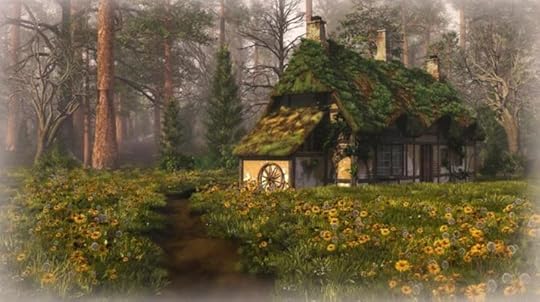 (Art by Artlier Sommerland)
(Art by Artlier Sommerland)And, indeed, the Pixie Ring is so protected, because Vassilya Darghrave is renowned in the fairy realms as a “Fey Chirurgeon,” a mortal who can solve ailments of the Fair Folk. This reputation stems from her saving a winged pixie from an (iron) bear trap when she was a child, right on the location where the Pixie Ring now stands. The pixie was a favorite of the a major Fey Court noble, who swore to protect Vassilya whenever she was in the field where she saved the pixie. No fool, Vassilya built a small cottage there as a teen, so she had a place to go if ill, moody, or in danger where the fey realm itself would defend her.
What Vassilya did not count on was other fairy creatures bringing her their problems. She has no special powers as a Fey Chirurgeon, just an expectation from sylvan beings that, given her reputation, she can fix any problem they bring her. Over the decades she has soothed a unicorn’s broken heart, stitched a shadow back onto its grig, made peace between warring lilac fields, split 1 keg of honey into 7 equally-large kegs promised to 7 fairy nobles by turning into mead, and nursed a whole host of sprites through winter cold by feeding them herbal soup.
Each fairy problem she has been brought has forced Vassilya to find a solution, which has often meant picking up a new skill. She’s become a master cook, herbalist, brewer, seamstress, woodworker, and painter. While she learned the basics of each skill through hard work and dedication, often travelling for months to reach a master able to teach her what she needed to know, once she used a craft to aid a fey creature, other fey creatures often paid her for her services in secret knacks. Spiderfolk taught her to weave secret eaves. Brownies shared their secrets of brewing morning dew. Tommyknockers showed her their woodworking techniques. As she practiced these arts, her humble shack grew bigger, and grander, and more beautiful.
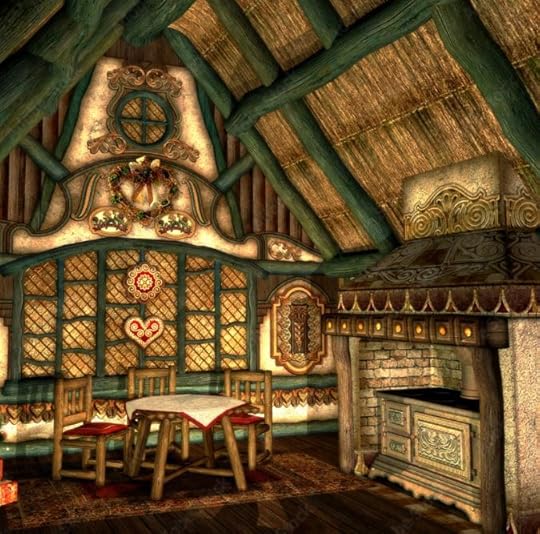 (Art by Artlier Sommerland)
(Art by Artlier Sommerland)In time, non-fey began to drop by as well, and being a hospitable person, she tended to feed and house them. In appreciation, most paid her… though she was just as likely to ask them to chop wood, or bring her hard-to-get seasoning on their next time through. Locals tried to keep her presence secret, but once a few traders found her, word of the off-the-path reststop spread. Vassslya slowly expanded her home, trading seasonable contracts with caravans for ceramic stoves in her fireplaces (no iron!), construction materials, labor, and unfinished furnishing she could refine herself.
Vassilya turns no one away. Those with problems are offered solutions if Vassilya can think of one, and given advice on where to get some if she can’t. The hungry are fed, the sick tended to, the tired allowed to rest. Payment is asked only of those who seem likely to afford it. Money is accepted (and tossed carelessly into a drawer, where fey friends carry it off to a more secure location, bringing her coins when she needs them), but trade and service are just as good. If someone just has one spare wagon wheel to trade, Vassilya takes it with the same gravitas as gold or a hand-painted doll. And, in her experience, someone will eventually come along who really needs a wagon wheel.
And, of course, as a crafter, she often turns broken barrels into tables for her garden. Indeed, she often repurposes something just before she or someone else unexpectedly find need for it. Even Vassilya doesn’t know if this is some effect of fairy influence, or is the fates just spun the thread of her life to overlap others’ at useful moments.
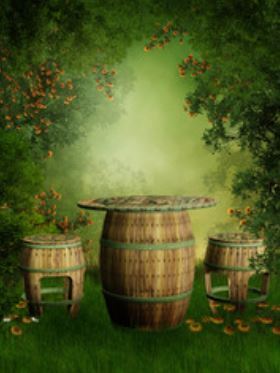 (Art by Obsidian Fantasy)
(Art by Obsidian Fantasy)The Pixie Ring is now a “common secret,” a place lots of travelers and traders know of, but most people don’t share knowledge of without good reason. Most people never see the fey who come for help, or the ones who have become friends and tend to live in her building. Their presence is sometimes hinted at, when birds help set the table, scuttering occurs in shadows, wolves and bears appear to growl at the unruly, or things get fixed or cleaned when left unattended. Those few people Vassilya consider close friends or family are more likely to be trusted with seeing the fair folk, as are druids, bards, and similar visitors, but only when “outsiders” are not present.
Vassilya does her best to not have to leave the Pixie Ring anymore, and often pays others to find materials or bring crafting manuals to her so she can fins the problems mortals and fey bring to her. In a more extreme case, if she must leave for a short jaunt, she finds someone she trusts (she’s an excellent judge of character) and leaves them “in charge” for a few days or weeks. When this happens, some shy minor fey almost always shows up with a problem they considered too minor to brother the “great fey chirurgeon” with, which may be as simple as needing advice on what to wear to a fairy dance, or as complex as being exiled from their home court under pain of death. Anyone who can successfully deal with such issues is generally rewarded, and often becomes part of Vassilya’s trusted inner circle.
PATREON
If you enjoy any of my various thoughts, ideas, and posts, please consider adding a drop of support through my Patreon campaign!, or dropping a cup of coffee worth of support at my Ko-Fi (which is also filled with pics of my roommate’s cat).
February 18, 2022
Themed Fantasy Tavern Week: The Wandering Monster
The Wandering Monster is an unusual tavern, in that it literally wanders. A sturdy 2-story wagon (or very small enclosed civilian siege tower, depending on how you look at it), The Wandering Monster is a combination mobile bar, potion and elixir shop, and residence for its owner, the retired gnomish alchemist and conjurer Kykin Dinferthort.
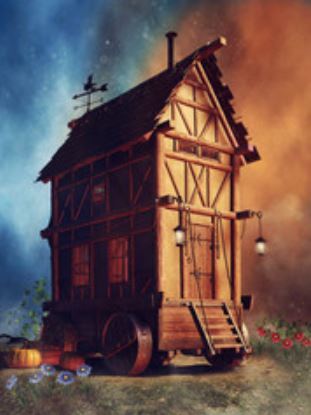 (Art by Obisidan Fantasy)
(Art by Obisidan Fantasy)Dinferthort trained to be a guild potion-maker, or possibly a court sage, but found the idea of living in a single location much too restraining to accept any of the standard positions upon ending his apprenticeship. Instead, he allowed himself to be hired by a band of adventurers delving into an ancient cistern complex (or, as Dinferthort refered to it, an “adventure hole”) to guard their basecamp and brew potions for them. This proved lucrative enough Dinferthort was able to buy a merchant wagon, and create a roving elixir business. He began traveling an “Adventure Hole Circuit,” hitting locations where adventurers were trying to clear out ancient labyrinths, long-lost sewers, chaotic caverns, buried cities, and other large-scale site-based sources of danger and wealth. Over time he discovered he could make more money on booze and cleaning or mending spells than potions, and upgraded his wagon to a full-fledged (if compact) mobile tavern.
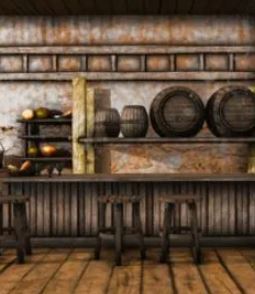 (Art by Obsidian Fantasy)
(Art by Obsidian Fantasy)The lower floor of the Wandering Monster has a single bard with a few casks and stools, though Dinferthort also has a number of leather cushions and tarps to make drinking outside nearby a comfortable option. The gnomish proprietor has focused on items popular with adventurers, including a few simple comfort foods, money-exchange spells (turning copper pieces into platinum pieces or even gems, for just a small cut), communication magic and, of course, healing and curse-removal potions and weapon oils. The upper floor is Dinferthort’s loft, bunk, and personal storage (which is tight, even for gnomish scale, but adequate for his needs… especially since he can conjur eextradimensional space if he needs it).
Dinferthort is friendly, but not stupid. He normally only uses his conjuring to provide a few assistants as needed to run his business and creatures to pull the Wandering Monster itself, but always has a fair number of combat and escape-related magics and conjurations ready, just in case. Usually, however, his services are just too useful to adventurers in the field for anyone to dare attack him, or cause trouble for the Wandering Monster.
PATREON
If you enjoy any of my various thoughts, ideas, and posts, please consider adding a drop of support through my Patreon campaign!, or dropping a cup of coffee worth of support at my Ko-Fi (which is also filled with pics of my roommate’s cat).
February 16, 2022
Owen Explains It All – Warbeasts for Starfinder
Before we get to any OGL content, an editorial aside:
First, this blog has spoilers for the finale of The Book of Boba Fett (and, by extension though less so, The Mandalorian). So if you want to avoid those, don’t read this.
Second, you may be wondering why is this tagged as an “Owen Explains It All” post, when that’s very unlike my normal marketing tone? Well, because this links into a show from the BAMF podcast I’m on, titled “Owen Explains It All!“. We do an episode every two weeks, picking new things from the zeitgeek to use as inspiration for game material, specifically the Starfinder Roleplaying Game.
We have a logo and everything!

So, whatever most people’s opinion on The Book of Boba Fett were (and, personally, I enjoyed all of it, though I always saw it as part of The Mandalorian‘s storytelling, so the tight links between the two shows didn’t bother me the way it did some people expecting each to stand on its own) most (though certainly not all) of the fan reviews I have seen say the final episode is well-worth watching the rest of the series.
And, when they both to say why (which IS a spoiler), it’s because Boba Fett rides a rancor into battle at the end of the episode, which hits the Ruel of Cool so hard I expect it to get its own entry on TVTropes.com someday.
What struck me, as a gamer, was how well that use of the rancor aligns with the idea of mechs in Starfinder Tech Revolution, which are presented as an option to allow PCs to take on encounters otherwise beyond them. The idea that, along with mecha, characters might have home bases, rancors, vehicles, minor allies, and other advantages they could pull out when appropriate spoke to me, and I though it’s be pretty easy to use the mech rules for near-kaiju-like warbeasts.
And all of that leads me to Warbeasts, as OGL content tying into Starfinder Tech Revolution.
Warbeast Rules
Unlike a mech, a warbeast can take actions without an operator. Indeed, often warbeasts without operators attack anything that attacks then, startles them, or attracts their attention. The take actions as a creature when lacking any operator. if you need any other statics, such as skills, treat the warbeast as if it was being controlled by a typical combatant NPC with a level 3 below the warbeast’s tier.
Warbeasts do not have shield points. Instead they have an equal number of Stamina Points, which are automatically restored (up to a maximum of the warbeast’s HP) with a 10-minute rest, or fully restored with a night’s rest. Warbeasts otherwise take damage as mechs (as do their riders, treating the cockpit as the saddle or hourdah of the warbeast).
Warbeasts are considered creatures, and can be targeted by spells and effects that target creatures, including mystic cure. You may wish to give the warbeast a type (often magical beast), which may also impact what abilities can affect it.
Warbeast Options
These are optional itsems you can slap on a mech statblock to change it to be more warbeast-themed.
No Ranged Attacks: If the base mecha has ranged and melee attacks, and you eliminate the ranged attacks for the warbeast, it gains +3 EAC and +2 KAC. If it normally does not have melee attacks, and you switch its ranged attacks to be melee, the warbeast only gains +2 EAC and +1 KAC. (Note that you can leave a warbeast with ranged attacks and just define them as kaiju-like breath weapons, eyebeams, projectile barbs, and so on.)
Exposed Rider: The rider’s position is not as protected as with a fully enclosed cockpit. Creatures may attack a controller of the warbeast directly, though controllers are always considered to have cover as long as the warbeast is active, regardless of where the attack against them originates. However, exposed controllers can also make attacks with their personal weapons without harming their warbeast. A warbeast with exposed controllers gets a +4 bonus to initiative checks, due to their much higher level of visibility of the situation around them.
Expanded Content
In addition to these warbeast rules, I created a simple option for using Resolve Points (or a lack of them) as a way to represent certain kinds of “old wounds,” a concept that developed as Jacob Blackmon and I discussed way to represent things from the show on the Feb 14th, 2022 episode of Owen Explains It All. This is bonus content for my Patrons, and is presented exclusively at my Patreon. You can join for a monthly cost of less than a cup of coffee!
February 15, 2022
Themed Fantasy Tavern Week: Titan’s Keg
Legend has it that the Titan’s Keg is partially built out of an actual keg of mead once owned by a titan, or at least a very large giant. This idea is reinforced by the fact the Meadhall section of the tavern has a deep, pleasant honey-mead scent permeating its wooden exterior and, of course, the barrel-like appearance of that section of the building.
 (Art by Warpaintcobra)
(Art by Warpaintcobra)The truth is more prosaic, though arguable interesting in its own right. The Titan’s Keg sits in a section of town reserved for residential shops and guild offices–places where people both live and work as crafters or representatives for crafters. The only enforcement mechanism for this vague zoning law is that shop signs must be approved by local crafter guilds, and to discourage public houses they don’t allow signs for inns or taverns. To get around this, the owner of the Titan’s Keg bought scrap wood from a shipyard wrecker, and used it to add a room to his home that had a keg-like appearance. The fact the wood came from a ship that had be damaged in a storm and hundreds of mead barrels had broken in its hold and soaked into the wood was a happy coincidence, though now the owner stains the interior wood every year with alchemical compounds that reinforce and restore the honey scent.
In addition to being a tavern and home, the Titan’s Keg is also the guild-independent shop of Ruvald Hain, an alchemist who specializes in food and flavoring. because his arts could be used to mask the taste of poisons (which he never works with), the Alchemist’s Guild and Herbalist’s Guild both insist he should pay them vast sums of money to oversee (and in his opinion, spy on and copy) his work. In defiance he refuses to join or work with either guild, and thus is only allowed to work in, sell from, and buy materials in his own building. The Titan’s Keg brings in most of his revenue (his experiments in flavors often leading to popular, often limited-time, drink flavors such as cheery mead, orange-blossom red wine, and the startlingly popular lime beer), which Ruvald spends convincing customers to bring him alchemical reagents for him to buy without doing business outside his building.
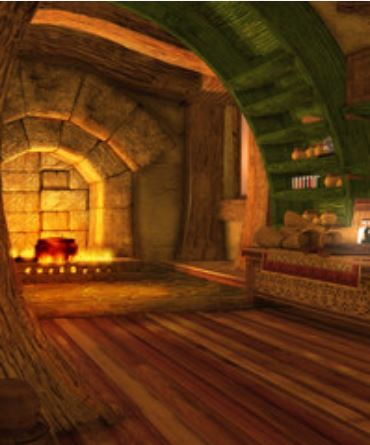 (Art by ratpack223)
(Art by ratpack223)The Meadhall of the Titan’s Keg is kept clean and brightly-painted. A cauldron is always on the fire, though patrons have learned to confirm it’s cooking food before dipping themselves a mug of its contents. The interior arches are lined with shelves that have serving plats and steins, but also various alchemical agents Ruvald doesn’t have room to keep in his residence. In fact, Ruvald’s personal possessions often end up scattered about, and regulars keep an eye on them to make sure no one makes off with anything important. Often, the unmarked bottles simply have flavor essences and preservatives but not always, and only Ruvald knows which is which.
Ruvald has a small, but dedicated staff of halfling and gnome cooks, bartenders, and servers who keep the place running smoothly more in spite of him that with his help. They also double as his alchemy assistants, housekeepers, and bookkeepers. He pays them well, but most work for him as a kind of informal apprenticeship, picking up culinary and alchemical knowledge by observing and assisting him. They keep the Meadhall open most hours, but if Ruvald is sick or sleeping after several days of work, they may insist everyone “keep it down” so he can recover.
PATREON
If you enjoy any of my various thoughts, ideas, and posts, please consider adding a drop of support through my Patreon campaign!, or dropping a cup of coffee worth of support at my Ko-Fi (which is also filled with pics of my roommate’s cat).
February 14, 2022
Themed Fantasy Tavern Week: The Rise and Fold
I’m looking at pulling a ton of my personal campaign notes, from up to 22 years ago, into actual for-sale polished products (maybe on Paizo Infinite, maybe just as rules-light, map-, art-, and flavor-heavy pdfs on OpenGamingStore and DriveThru –anyone have opinions on which you’d rather see?).
That includes a TON of material I wrote on locations for 3.x/Pf1/4e/Wizards & Warlocks games–some as part of old professional projects that ended up not happening, some for home campaigns, some for my previous online efforts before this blog. While a great deal of that material really needs the conext of a world or city to link it to, some stand on their own pretty well as drop-anywhere fantasy locations.
Especially the taverns.
Throughout this week I’ll be putting out short descriptions of four Fantasy Taverns. they are designed to be unusual and interesting, the kinds of places PCs gravitate towards, investigate, buy, or turn into regular hangouts. (Wednesday will be an Owen Explains It All article tying-in to the show recording Feb 14th.)
None of these are as complete as I’d produce as for-sale products (which would include exterior shots, interior shots, and maps for each one), but if you like these snippets, let me know and maybe I’ll add some polish to the bigger entries of my old material and turn them into a professional product. The longest entry is the first one, and the rest are currently more written sketches. But, if they are popular enough, I can easily do another week worth of entries from Feb 21-25.
The Raise and Fold
Officially, The Raise, a Public Parlor and The Fold Alehouse are two different businesses, and indeed they have two different owners. It’s not even known if the owners like each other–they are never seen together or speak of one another–but they obviously have some kind of arrangement to benefit both establishments.
But since the two businesses are the top floor and bottom floor (respectively) of the same building, and a tab run up at one must be paid off before purchases can be made at the other, and they both feature gambling and drinking, people just call them The Raise and Fold, unless greater specificity is needed.
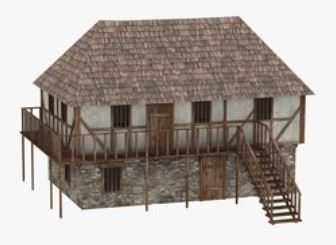 (The Raise and Fold, art by 3drenderings)
(The Raise and Fold, art by 3drenderings)The Raise, A Public Parlor
“The Raise” is run by Gyster Feirn, a half-elf poet and scion of a winery-owning family who seems to have been stuck with the tavern to wait from him to “season” over a few decades before being allowed to benefit from any other familiar businesses. Feirn is genteel and runs a small, expensive, selective establishment where from dusk to dawn there is always a table of high-stakes As-Nas being run by the house and buying 20 gp/glass drinks is part of the cost of participating. In addition to socializing and playing cards, numerous deals are made within the parlor of “The Raise,” often including the buying and selling of “opportunities,” which range from the rights for caravan goods stolen by bandits (which you can buy for coppers and the gold… but then need to go recover yourself), to ancient maps, logbooks from sunken cargo ships, and debts due to be collected from grumpy dragons or infamous wizards.
Feirn acts as host and card dealer more than proprietor. Business issues are generally handled by the quiet, taciturn dwarf Drun Ironnail, who rumor suggests is related to the owner of “The Fold,” though no one who would know is ever willing to talk about that. Drun is a very minor spellcaster, using cantrips to clean and brighten the room and fetch drinks, spending about as much time in the tiny “back room” (where money goes and drinks come from) as in the parlor which takes up most of the upper floor. No one else seems to work for “The Rise,” though if anyone starts trouble, “cudgelers” from “The Fold” quickly stomp up the stairs to deal with it.
“The Raise” is kept bright, clean, and fresh-smelling, with comfortable and high-end (though mismatched) furnishings, warm carved wood tables and posts, and is set up more like the sitting room of a minor noble than a pub or gambling house. Pillows, books, flowers, and teapots are common, with many patrons appreciating a hot tea chaser and a few sweetcakes to go with their fine wines and expensive card games. Small trays of foods keep easily, including sweets, cheeses, nuts, and dried fruits, can be purchased along with a vast and ever-changing wine, mead, and spirits list.
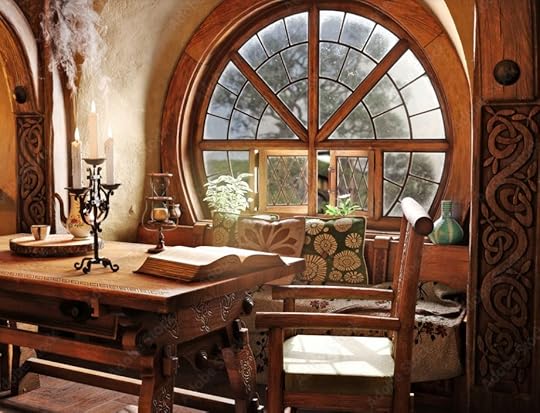 (The Raise Parlor, Art by Digital Storm)
(The Raise Parlor, Art by Digital Storm)No one gets into “The Raise” unless they are a member, the guest of a member, or are recommend by Maridern of “The Fold.” Anyone who makes trouble or can’t pay their debts are banned from “The Raise,” and directed to “The Fold.”
The Fold Alehouse
The Fold is much lower in asperations than it’s upstairs neighbor, but is also shockingly much, much larger. Though from the outside it looks to take up only a single lower story, in fact “The Fold” has 5 lower levels, which have rooms for for private meetings and parties, storage, cooking, living quarters for its owner and her “cudgelers,” a small infirmary, and a vault (in the middle of lower-level 3, with no exterior wall that doesn’t have a room on the far side). Lower levels are always guarded, and are heated by brick stoves connected to the main kitchen fires.
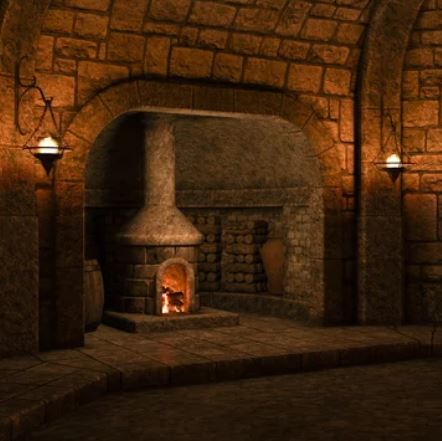 (Lower level stove in The Fold, art by Ralf Kraft)
(Lower level stove in The Fold, art by Ralf Kraft)However, most patrons never go below the main level, which is the open “Aleroom,” a dark space light by candles (which seem to glow more than their flames should suggest), with sturdy wooden furnishings designed more to survive a brawl than provide comfort. The walls and floor are stone, the room more thick wood (though any loud commotion from “The Raise” can clearly be heard), with a few fire pits, a serving station and a secure counter and door where cudgelers watch for troublemakers, and keep anything the Tavern’s owner, Maridern decides not to let patrons hold on to while drinking.
Maridern is a older dwarven woman whose face has been compared to an dried potato… a comparison she doesn’t mind. She’s an ex-adventurer, though no one is sure how long ago or what her area of specialty was, and she retired to “the Fold” when her bones creaked more than the doors she’d burst through. She runs her Alehouse like the stern grandmother of a rowdy family, shamelessly admitting she has favorites who get better deals and care than typical patrons, and if someone doesn’t like it they can drink and play tiles elsewhere. In addition to a diverse crew of staff (which Maridern treats as her grandchildren–for good and ill), there are a half-dozen “cudgelers,” enforcers of good behavior that are trained to use their cudgels to make a point without killing anyone. At least, not anyone who behaves after getting cudgeled once.
“The Fold” offers cheap but not watered-down drinks, simple food (leaning towards stews, meats, grains, root vegetables, and fungus), and a a rule that stealing or stabbing a fellow patron will be dealt with harshly. The second rule in the Fold is that if anything said would mean you have or were going to break the law or insult or threaten someone, you are assumed to be lying for entertainment of others. This rule is the source of many tall tales, but also allows lawmen and rogues and members of opposing factions to drink at the same table, though overlooking such statements doesn’t always last beyond the alehouse’s walls.
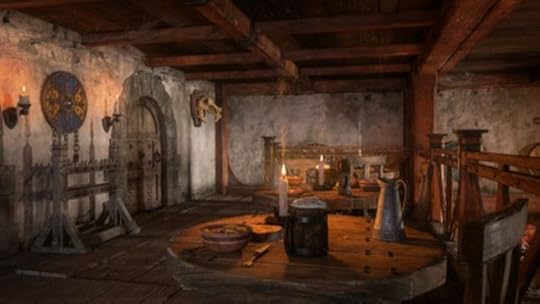 (The Fold Aleroom, art by IG Digital Arts)
(The Fold Aleroom, art by IG Digital Arts)If someone drinks until they pass out, or is knocked out, they get moved to the corner near the cudgelers, and looked after until they come to. The major pastime is betting on games of “tiles,” a dwarven dominos-like game played with square tiles with numbers on all 4 sides, and one of the 4 corners. Maridern loves teaching tiles to new players, and allows trusted players to set up coin-per-round tables, but never, ever plays or bets on the game herself.
Newcomers pay for all services in coin-in-advance, but someone clearly down on their luck, and trusted regulars, are allowed to run up a tab. Tabs in theory come due every month, but Maridern often allows token payments for those who are genuinely trying to make good. She also appears to buy debts from “The Raise,” and people not allowed into that establishment for any reason that doesn’t put them in jail are generally allowed to work off their debts (or reputation as a troublemaker) by working at “The Fold.”
Another way to wipe out a debt is to “leave your sword.” In this case something Maridern accepts as an important weapon or tool owned by the debtor is left behind, stacked up on a counter behind the cudgeler post in the Aleroom. Anyone can buy it for whatever the debtor owes (including the debtor if they come into money later), or when the ex-debtor shows up again, Maridern retains the right to give it back to them, in return for it being used to perform a service for her. Maridern has a reputation for being harsh, but not evil, and while she has given people back their swords and told them to go kill someone, in general that’s always been someone the community agreed needed killing.
The Fold is often a popular bar for mercenaries, guards, thieves, and adventurers. Maridern often directs people toward, or away, from such careers as she judges best for them, though she never insists. She also lets people coming up in the world, with money and class and manners, know that if they want, she can get them an invite into “The Raise.” Some adventuring groups have formed from tables of regular tiles players having one of their number begin visiting the Raise, then coming back with an opportunity for adventure for which they need assistance.
PATREON
If you enjoy any of my various thoughts, ideas, and posts, please consider adding a drop of support through my Patreon campaign!, or dropping a cup of coffee worth of support at my Ko-Fi (which is also filled with pics of my roommate’s cat).
February 11, 2022
Axes & Arcana, a Fiction Intro Snippet
I wrote this more than a decade ago. This is all there is of it– no outline, no list of names or plot points. Just the beginning of an introductory scene, likely to be incomplete forever, hanging as insecurely as the character in it.
ONE
The sound of rain splattering on the floor of the chamber was rudely interrupted by the loud clang of a three-tined metal hook bouncing through a hole in the ceiling. The hook swung on the end of a knotted rope, dancing mid-air as the rope jerked and swayed. Then the rope disappeared back up through the hole, the hook traveling with it. The hook rang like a bell as it popped back past the edge of the gap it had come through, and disappeared up into the rainy night beyond. For long moment, the chamber was again filled only with the sounds of rain falling down through the same rough opening in the stone roof, to patter against the worn tiled floor. The water pooled, then meandered like a snake in a thin, dirty stream that weaved past rusting helmets and yellowed bones strewn across the old tile floor, until it flowed with a quiet gurgle down a rock ramp corridor that exited the chamber. Even when lightning flashed its harsh brightness through the hole in the ceiling, followed seconds later by thunder, the light did nothing to illuminate the dark corridor, or show the stream’s final destination.
The metal hook banged across the rock at the top of the hole, without falling in, and was again dragged away. A muffled curse, invoking gods too dead or imaginary to be offended, echoed into the chamber and then the hook came flying into the old stone room once more. This time when the knotted rope was pulled back, a single tine of the hook caught on the lower edge of the ceiling’s hole, and the rope was tightened against it. And then, the chamber was again filled with only the gentle patter and gurgle of the rainwater.
Before long, cursing could again be distantly heard thought the ceiling’s opening. Though closer and louder than before it was no more imaginative, mostly focusing on improbably sexual positions and the dubious heritage of the architects who had chosen to build the chamber, and the complex it served as entrance to, so high in the mountains. Had the architects been around to hear such speculation they would have been filled with rage, and likely summoned demons and spectral horrors to strike down the blasphemers. But not only were they all long dead, the moldering remains of several of them actually lay in the damp room, their impotent bones scattered and once-rich garments turned to tattered rags. The architects had claimed that even in death they would defend the chamber, but their complete lack of action gave lie to the ancient pledge.
More than half an hour after the hook had first banged its way into the chamber, a second knotted rope was slowly lowered through the rain-filled air from the gap in the massive stone slab that served as the room’s ceiling, its lower end coiling neatly on the wet floor. A thin, nimble figure was silhouetted in the gap of the ceiling as lighting and thunder flashed across the sky above, and then his pale, exposed body slid down the second rope. He was breathing heavily and might have been sweating, though the rains lightly pelting him made it impossible to know for certain. He had a strip of cloth wrapped around his groin and another above his eyes, and leather straps protecting his palms and feet, but was otherwise unclad. He slipped easily down the rope, letting his feet and hands slide nimbly over the rope’s knots. While still a score of feet above the ground, he paused on the rope and spoke softly. The words were sibilant, soft, and yet seemed filled with great value, as if he was whispering something terrible and important.
“Feis’ithifv.”
As the sounds — never designed for human lips — slipped away in a hush, a blue mote of light formed in the air beside the thin man. The mote drifted down below him, to bounce gently off the pooling water on the floor – though it created no ripples. The man watched it roll for a few feet, then come to a stop. It was little more than a single candle’s worth of light, and he had to peer through the rainfall still all around him, but he rushed nothing. Every inch of the corridor he examined from his perch on the rope, taking note of the water trickling out the only exit, the bones and armor, the cracked altar against one wall, and the smashed statue against another.
PATREON
If you enjoy any of my various thoughts, ideas, and posts, please consider adding a drop of support through my Patreon campaign!, or dropping a cup of coffee worth of support at my Ko-Fi (which is also filled with pics of my roommate’s cat).
February 10, 2022
MoviePitch: “The Cabin at Camp Sorority Lake”
A group of very different women, who clearly have all survived horrifying and dangerous experiences, gather to deal with the evils they’re sure are lurking near the about-to-be-opened eponymous cabin.
And this time? They’re prepared.
Ideally this would be “The Expendables,” but with actresses who have survived horror and horror/action movies.
(For example, they all take out million-dollar life insurance policies, and name each other’s friends and families as beneficiaries. But not the group themselves — no one who is going to be at the Cabin is benefitting directly).
“Is that a chainsaw?”
“Yep. Top-handle 16-inch always-start Stihl, with custom grips and fuel gauge.”
“Did you get it from… yaknow?”
“Oh, heck no, he used a stupid-huge, heavy, rusty monstrosity. Bad for combat. I DID salvage some of the links from it’s chain, though.”
“Nice!”
“So, you wear full body armor?”
“When hunting, with backup? Fuck yeah. NIJ-certified Level IV. You don’t?”
“No, I prefer stealth and mobility. I have a stab-resistant undersuit. Machete-resistant, too.”
“Tested it against power drills?”
“Haven’t had the opportunity.”
“All right, precheck. Defiled indigenous holy sites or burial grounds?”
“I mean, yes. But no more than anywhere else in this country. None of the surviving original local cultures have any specific warnings for us. I asked.”
“Toxic dumps?”
“Not that the eco-groups I talked to are aware of.”
“Illegal labs?”
“Shipping and power records suggest no.”
“Previous incidents?”
“Three recorded massacres, roughly one per generation. Just rare enough for people to forget. Always on a solstice. Like the one coming up.”
“So, cult or supernatural evil.”
“Seems likely. I have silver, jade, white oak, mistletoe, holly, salt, and holy water — in Catholic, protestant, and Eastern Orthodox flavors. And some from a guy named Giles. Oh, and bullets. Lots of bullets.”
“Sounds good, let’s go.”
I specifically wanted a mashup title for this idea, but after expanding a bit I wondered if “Final Girls” would be a better choice. But, it turns out a movie by the title already exists and is just similar enough (it’s kind of Scream via Last Action Hero; an actress’s daughter and her friends get pulled into the actress’s horror movie, giving them a change to use their self-aware trope knowledge to defeat the killer) that I think it’s better not to risk confusion.
PATREON
If you enjoy any of my various thoughts, ideas, and posts, please consider adding a drop of support through my Patreon campaign!, or dropping a cup of coffee worth of support at my Ko-Fi (which is also filled with pics of my roommate’s cat).
February 9, 2022
Boosting Less-Useful Options in PF1
Look, there are options in PF1 that, though not terrible, are simply and easily identified as less-potent than alternatives with the same cost *be that in gp, exp., feat slots, or whatever). These things aren’t bad, they’re just not as good. And, thus, players often don’t care much about them, and they do not interject any excitement into the game.
Which means there’s a lot of material that’s unlikely to get used in your game, and won’t spark excitement if it does.
But it can.
Here are four options to make players excited about gaining less-than-stellar options. Of course it does that by making them cheaper, more useful, or both. So, there are pure power-ups. I wouldn’t recommend using more than one of these options in a campaign, and even then only if you want some power-up and to see new toys get used more often.
Generally Competent: At each level, PCs gain a bonus feat. This must be a general feat, cannot also be any other type of feat, and cannot have any prerequisites. It must be a feat no other PC has taken. (If two players want the same feat at the same level, have them roll d20s with highest-roll going first. If someone wins such a rolloff, they automatically lose against a player who has won fewer rolloffs.)
No “I” In Adventurer: At each level after 1st, the PCs all gain a bonus teamwork feat. Only one of them has to meet its prerequisites. If the players can’t decide on a teamwork feat, they vote among the choices, with a rolloff deciding any tie.
The Magicker the Merrier: At each level, the PCs all gain a bonus feat for which they meet the prerequisites. This must be a feat of the Blood Hex, Conduit, Damnation, Item Creation, Item Mastery, Medatation, or Metamagic type.
The Useless Magic Item Tango: Once per day, a PC can have a magic item use their character level as its caster level, rather than its listed level. Alternatively, once a day they can have an item’s save DC be calculated as 1/2 character level + highest ability modifier.
PATREON
If you are enjoying any of these, please consider adding a drop of support through my Patreon campaign!, or dropping a cup of coffee worth of support at my Ko-Fi (which is also filled with pics of my roommate’s cat).
February 8, 2022
Star-Crossed Species: Huitz’zysha
I haven’t worked on crossbred Starfinder species in more than four years, but it came up recently. So, here’s at least one more star-crossed species entry, and we’ll see if people like them enough for me to make more.
Huitz’zysha
Rare in most places, numerous huitz’zysha can be found on Vance IV, a thickly forested world in the Vance system also known as Morreion.
The Vance system is just beyond the furthest world of the Ioun Imperium in terms of real distance (less than a light-year away), despite being a lengthy jump through hyperspace. It’s existence is not known to the Imperium, but it is known to several clans of who foresaw its importance generations ago due to the visions of powerful precognitive seers. As a result, when huitz’plina from those clans manage to travel off-world, they often make a pilgrimage to Morreion. Many retire there, and several small huitz’plina settlements have developed on-world.
By coincidence (or perhaps not coincidentally, given the huitz’plina precognitive visions regarding the system), due to a hyperspace wormhole, the Vance System can easily (and even accidentally) be reached from a Forest Moon in the Core Worlds. The Forest Moon in question happens to be the homeworld of the maraquoi, who have experienced a significant boost in technology resulting in many hyperspace trips off their world. On some of them, the route to Morreion was discovered, and a significant maraquoi settlement was established.
When the huitz’plina and maraquoi encountered one another, they found significant appreciation in eac other’s culture, art, food, and music. A joint council was set up to ensure all claims to the planet were respected, and peacefully settle disputes. As the maraquoi settlement was larger and more advanced, number huitz’plina took up residence there. Friendships and even romances blossomed. In time, it became commonplace for a huitz’plina to be asked to serve as a zysha-vennin, or “spiritual ancestor” of pregnant groups of maraquoi–essentially an honorary role based off the zysha, or “facilitators,” one of the seven genders of maraquoi that are not part of the physical act of reproduction, but are crucial to it, and still somehow contribute their genetic material to the offspring.
It came as some surprise when a huitz’plina zysha-vennin turned out to be able to act as a true zysha, contributing genetic material to their honorary descendent. These mixed-species offspring were known as huitz’zysha, and were cherished and welcomed by all the settlements of Morreion. In time, a huitz’zysha formed a family with both maraquoi and huitz’plina, and discovered they could substitute members of both species for various genders each group normally used to produce offspring. And, then, a huitz’zysha group of maraquoi and huitz’plina included a beloved lashunta friend as a zysha-vennin… and discovered that any family with a huitz’zysha could add genetic material from other species who served as zysha-vennin.
 Huitz’zysha-shunta, by Jacob Blackmon
Huitz’zysha-shunta, by Jacob BlackmonAs a result, there was an explosion of huitz’zysha being born and cared for on Morreion, often taking on physical traits from other species as well. The complex love-binding groups that grew up around this share a great deal with maraquoi 7-gendered parenting groups, but also have various polyamorous and friend-bonded traditions adopted from huitz’plina, lashunta, elven, vesk, and orcish cultural norms. Huitz’zysha are raised knowing that they are the product of strong, complex relationships of caring parents, friends, and relatives.
Though huitz’zysha can differ wildly in appearance, they all share the same species traits (though some of those are flexible depending on their exact ancestry).
Racial Traits
HP: 2
Ability Adjustments: Huitz’zysha come in numerous shapes, sizes, and dispositions. A huitz’zysha gains a +2 bonus in two ability scoes of your choosing, and a -2 penalty in one ability score.
Size and Type: Huitz’zysha are medium humanoids with themaraquoi and huitz’plina subtypes, a 20 foot speed, and a 20 foot climb speed. At character creation a huitz’zysha may either select another medium humanoid subtype to gain (representing an additional genetic ancestor), or begin with 4 bonus species HP rather than 2. The subtype cannot be from a species with an ability that allows them to be treated as another type (such as plantlike).
Kith’s Appearance: Huitz’zysha do not take penalties to Disguise checks to look like another species that is a medium huamnoid that has the same subtype they do.
Senses: Huitz’zysha have blindsense (scent) with a range of 15 feet, blindsense (sound) with a range of 15 feet, darkvision with a range of 30 feet, and lowlight vision.
Prehensile Tail: All huitz’zysha have a tail that is as effective as a hand at manipulating objects, which allows them to wield and hold up to three hands’ worth of weapons and equipment. This does not increase the number of attacks they can make during combat.
Huitz’Zysha Feats
Though physical and mental therapy, a huitz’zysha can learn to access abilities from their ancestors not universal to all their kind. By expending a feat, a huitz’zysha can gain one of the following abilities if a medium humanoid species with one of the same subtypes the huitz’zysha has gains it: amplify, animated, agile, amphibious, astute, battle-hardened, bloodscent, brachiator, boneyard conditioning, buoy, change shape, cold ensured, cold resistance, convivial, cooperative, distracting buzz, burrow, dream skill, drow immunities, dual nervous system, easily augmented, electrical affinity, electricity resistance, elven immunities, empathic, espraksa movement, enveloping grip, favored object, fearsome, fierce survivalist, find weakness, fire resistance, flexible, forest friend, glider, gravity adjustment, heat tracker, hold breath, imago movement, intellectual knack, jumper, lifebound, lurker, malleable limbs, mechanical talent, multicultural, natural agility, natural communication, natural swimmer, natural weapons, necromancy resistance, nightborn, nimble, orc ferocity, perceptive, pounce, predreaming, psychometry, radiant, regenerative evolution, rugged travel, scrappy, shards of the past, shared stillness, shift limb, simulacrum, skin mimic, slow but steady, spine assault, sneaky, stonecunning, stony plates, strix mobility, sturdy, survivor, survivalist, suspicious, talented, telepathy, third eye, tinkerer, trimorphic, twinkle, versed, wary, and wasteland dweller. A GM may choose to allow additional appropriate species traits, if desired.
Spending a feat can also double the range of their species trait blindsenses and darkvision. A huitz’zysha can take additional feats to gain additional species traits it qualifies for, but cannot take the same trait more than one, or take traits from species that are not Medium humanoids with a shared subtype.
Vital Statistics
Huitz’zysha have the height, weight, and aging characteristics of one Medium humanoid species that shares a subtype with them, selected at character creation.
PATREON
If you are enjoying any of these, please consider adding a drop of support through my Patreon campaign!, or dropping a cup of coffee worth of support at my Ko-Fi (which is also filled with pics of my roommate’s cat).
Owen K.C. Stephens's Blog
- Owen K.C. Stephens's profile
- 7 followers



